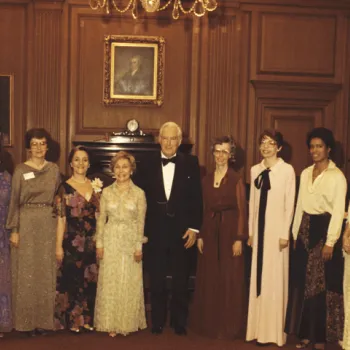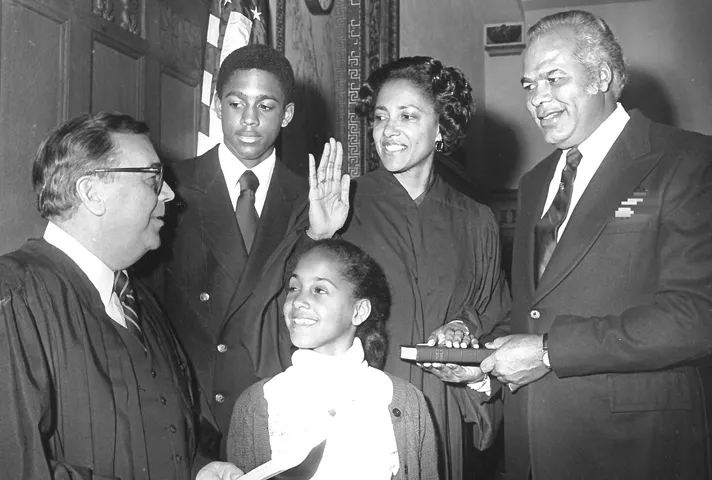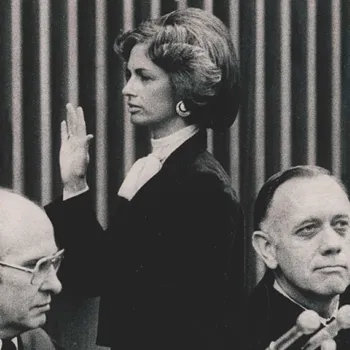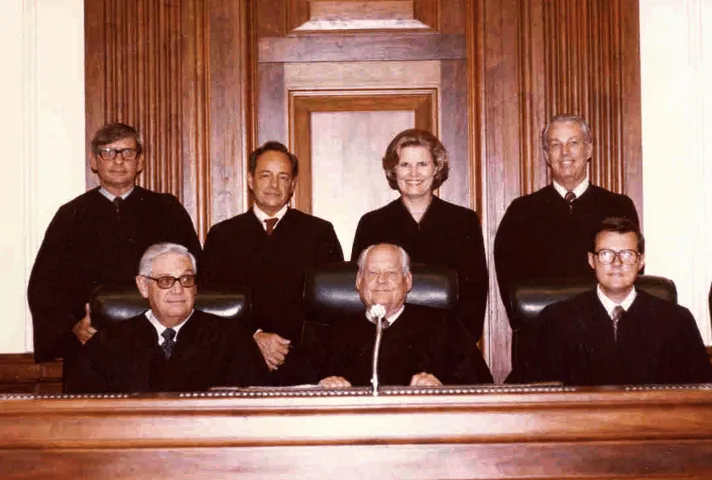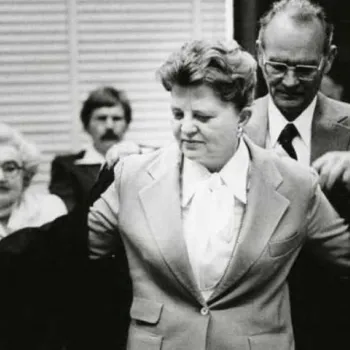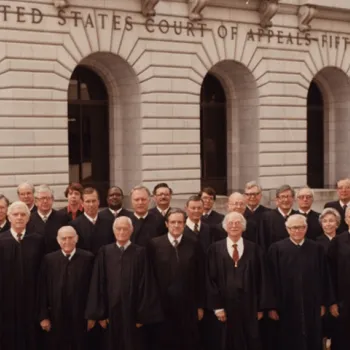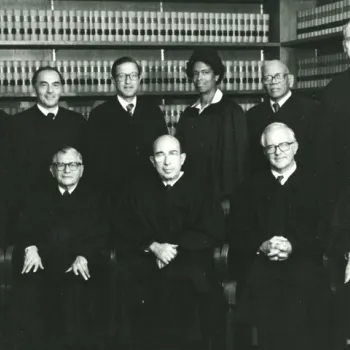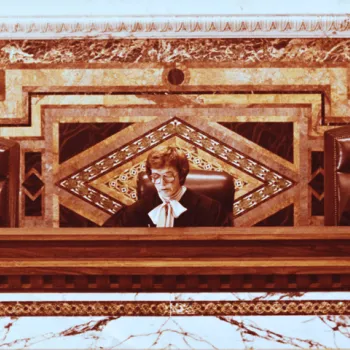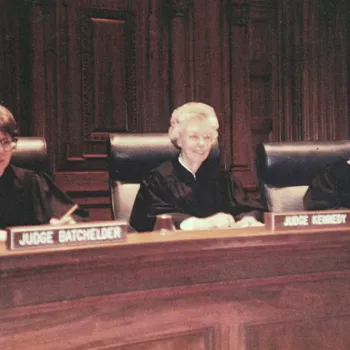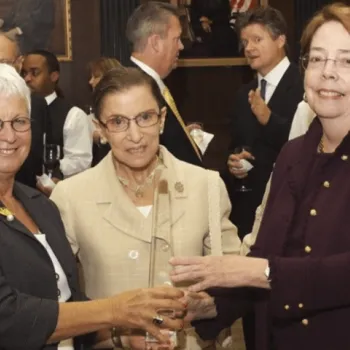Federal Judge Sylvia Rambo first thought of a legal career in the 1940s when her school bus drove by a local law school in Carlisle, Pennsylvania. “It was like a voice came out of nowhere,” she recalled, “saying, ‘You’re going to be a lawyer.’ ”
Dorothy Wright Nelson felt a similar urge while helping poor children as a YMCA youth counselor: “I’d wanted to be a social worker, but I thought I could help them more as a lawyer.”
Read the Series
This is the first in a series of articles about 23 women judges who in 1979 reshaped the federal Judiciary.
Rambo and Nelson did more than become lawyers. They became legal trailblazers. Entering law school in the postwar Baby Boom years, a time when women were steered toward homemaking, they joined a historic class of women judges who forever transformed the federal Judiciary.
In 1979, 23 women were appointed to life-tenured U.S. judgeships—more than doubling the number of women appointed as federal judges in the previous 190 years. The doors they opened never swung shut again. Today, there are 363 female judges, including three Supreme Court justices. Women make up one-third of the courts’ full-time, active Article III judges.
Forty years after their confirmation, the women judges of 1979 remain proud of their role in history.
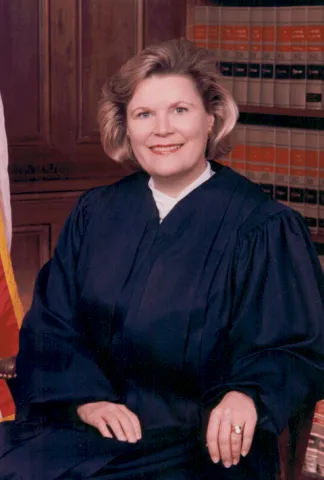
Judge Susan H. Black. Photo courtesy of Judge Black.
“I’ve lived a full life, not just a long one,” said Susan H. Black, a judge on the 11th Circuit U.S. Court of Appeals. “Our appointments drove the stereotypes away. At long last, women were looked at the same way men were looked at.”
The judges benefited from a perfect storm of opportunities: a president determined to diversify the Judiciary; a new vetting system that helped candidates without political connections; and a 1978 law that created 153 vacant judgeships.
The key, however, was a new generation of women lawyers who were so conditioned to breaking glass ceilings that they weren’t daunted when their opportunity arrived.
Judge Rya Zobel, of the District of Massachusetts, barely spoke English when she emigrated from war-torn Germany. In the 1950s and ’60s, she attended Harvard Law School and became her law firm’s first woman partner, just as more women were entering the law. “Despite our personal struggles in a time of undisguised discrimination,” she said, “we were exceedingly fortunate to be lawyers at the beginning of a sea change.”
During interviews, the judges traced their professional confidence to their families. Despite society’s attitudes about women in the workplace, they said their parents, and later their husbands, treated them as equals and supported their interest in the law.
Before becoming a U.S. district judge in the District of New Jersey, Anne Thompson was a public defender, a municipal judge, and among the very few African American women to serve as a district attorney. She was inspired by her father and mother, who attended segregated schools in the South before becoming a dentist and teacher, respectively, in Philadelphia.
“My mother was a woman who knew nothing but discrimination, but she had an openness and energy, embracing the world and people of all types,” Thompson recalled.
In the 1950s, all-male faculties and law firms were common, and in most law schools, women students could be counted on two hands. Women often felt unwelcome.

Judge Mary Murphy Schroeder. Photo courtesy of Judge Schroeder.
At the University of Chicago, Judge Mary Murphy Schroeder recalled, male law students were housed and fed next door to the law school. Women law students walked more than a mile to class from off campus. Even on the most bitter winter days, the women were denied hot meals at the men’s dorm.
Schroeder, now a judge on the Ninth Circuit U.S. Court of Appeals, fell ill and was hospitalized the night before her first final exam. She was threatened with an F and only grudgingly was allowed to take her exams in her hospital room. “I was determined I was going to finish the job I had started,” she said. “I wasn’t going to let anything get in my way.”
At Harvard Law, a recruiter told Stephanie Seymour he had no interest in hiring women. She later became his firm’s first female lawyer. After Seymour moved to Tulsa, Oklahoma, a bailiff in state court briefly barred her from sitting at the counsel’s table because “only lawyers are allowed here.” She set him straight.
None of the resistance fazed her. “It ran off my back,” said Seymour, a judge for the 10th Circuit Court of Appeals. “By that time, I was confident in my own ability.”
However, most Class of ’79 judges recalled a kinder reception.
“I heard later that many women were treated terribly at their law schools, but my school [the University of Wisconsin] couldn’t have been more welcoming,” said Barbara Crabb, a district judge in Madison, Wisconsin.
Along the way, several of the women judges juggled family obligations that professional men rarely faced.
“My late husband was very supportive psychologically and emotionally, but he was not very helpful around the house,” Thompson said. “I really worked very hard. I was taking kids to the orthodontist, getting their sneakers, enrolling them in special schools. I didn’t have time to worry about whether I was accepted, liked, or loved by my colleagues.”
The judges, now in their mid-70s to early 90s, all might have had quietly distinguished careers, had history not intervened.
In 1977, when Jimmy Carter entered the White House, previous presidents had appointed 1,824 life-tenured federal judges. Only 23 were African Americans, and just 10 had been women. Carter pledged to diversify the Judiciary.
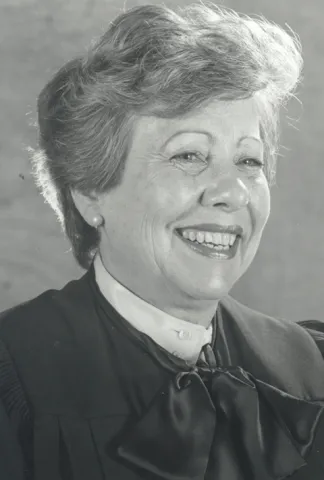
Judge Dorothy Wright Nelson. Photo courtesy of Judge Nelson.
Then-Attorney General Griffin Bell asked Nelson, as USC Law School dean and chair of the American Judicature Society, to help establish non-partisan commissions to review potential judges based on legal ability. Carter also wanted the commissions to identify qualified women and minority candidates.
“I think Rosalynn felt this way, and he also was inclined,” Nelson said. “He always inserted women and minorities when he talked about appointments. The fact that he acted on it, I thought, was quite remarkable.”
The nominating commissions, made up of lawyers and non-lawyers, lessened senators’ political influence on the nominating process.
Despite her experience as a federal magistrate judge, Crabb said a male state legislator was favored by a U.S. senator for a new judgeship in the Western District of Wisconsin. But the nominating commission rejected the legislator, ruling him out.
The nominating panels also had women members, which may have saved Seymour’s judicial hopes. Seymour later learned her file was discarded by her vetting commission’s chairman. As a mother of four, he claimed, she couldn’t possibly handle the workload of a federal appellate judge.
That changed when a leading male candidate was discussed. “A woman on the commission who had quick wits said he wasn’t qualified because he had five children and couldn’t possibly handle the job,” Seymour said. “She saved me from being thrown in the waste basket.”
After their appointments, each judge found unique challenges and satisfactions.
Rambo was being interviewed for a judgeship in the Middle District of Pennsylvania when a horrific nuclear reactor accident occurred at Three Mile Island. “I was watching TV and I said, I wonder who’s getting that litigation,” Rambo recalled. “My husband said, ‘I think I am looking at her.’ ”
The TMI litigation lasted two decades. Rambo eventually ruled that claims of health injuries could not be reliably linked to radiation leaks. The Third Circuit Court of Appeals upheld her controversial decision.
Black, a Florida judge before Carter appointed her in 1979 as a district judge for the Middle District of Florida, found it easy to adjust to managing federal trials. When President George H.W. Bush named her an appellate judge in 1992, the adjustment was harder.
“I was surprised by how hard the judges worked. Like a lot of district judges, I thought it would be easier on a court of appeals,” Black said.

Judge Betty Binns Fletcher. Photo courtesy of the ABA Women Trailblazers Project.
The women judges often broke new ground, and felt pride as they did so. Eleven of the 23 women eventually served as chief judges of their courts, and seven served on the Judicial Conference of the United States. Zobel was the first female director of the Federal Judicial Center, the Judiciary’s research and education arm. On March 11, 1981, two 1979 appointees were part of an all-female merits panel for the Ninth Circuit.
“We understand this is an historic occasion,” Judge Betty Binns Fletcher, of the Ninth Circuit Court of Appeals, said in a statement from the bench that day. “Not only is it the first time that three women have sat together as a panel of appellate judges in the Ninth Circuit, but, we believe, in the United States and perhaps in all the world. … We rejoice in it, and we hardly believe it.”
The women judges of 1979 differ on whether having more women on the bench necessarily changed how cases are decided, but they agree that greater gender equality among federal judges is important.
“It’s a sign that America was maturing and growing up,” Nelson said. “A lot of women who were lawyers were doing outstanding jobs. I think it has enriched the quality of justice. I consider it a very positive thing for the United States of America.”
Editor's Note: This is the first in a series of articles about 23 women judges who in 1979 reshaped the federal Judiciary. Next story, on Aug. 21, features Mary Murphy Schroeder.
| Name | Court | Bio from Federal Judicial Center | Online Oral History or Other Resource |
|---|---|---|---|
| Susan Harrell Black |
Middle District of Florida Appointed to Eleventh Circuit Court of Appeals in 1992 |
Biography Information | |
| Barbara Brandriff Crabb | Western District of Wisconsin | Biography Information | |
| Orinda Dale Evans | Northern District of Georgia | Biography Information | |
| Betty Binns Fletcher | Ninth Circuit Court of Appeals | Biography Information | ABA Women Trailblazers Project |
| Joyce Hens Green | District of Columbia | Biography Information | |
| Shirley Brannock Jones | District of Maryland | Biography Information | |
| Amalya Lyle Kearse | Second Circuit Court of Appeals | Biography Information | |
| Cornelia G. Kennedy | Elevated to the Sixth Circuit Court of Appeals in 1979 after first being appointed to the Eastern District of Michigan in 1970. | Biography Information | ABA Women Trailblazers Project |
| Carolyn D. King | Fifth Circuit Court of Appeals | Biography Information | ABA Women Trailblazers Project |
| Phyllis A. Kravitch |
Fifth Circuit Court of Appeals Reassigned to the newly created Eleventh Circuit Court of Appeals in 1981. |
Biography Information | ABA Women Trailblazers Project |
| Gabrielle A.K. McDonald | Southern District of Texas | Biography Information | |
| Dorothy Wright Nelson | Ninth Circuit Court of Appeals | Biography Information | ABA Women Trailblazers Project |
| Sylvia H. Rambo | Middle District of Pennsylvania | Biography Information | |
| Mary Lou Robinson | Northern District of Texas | Biography Information | U.S. Courts News |
| Mary Murphy Schroeder | Ninth Circuit Court of Appeals | Biography Information | ABA Women Trailblazers Project |
| Stephanie Kulp Seymour | Tenth Circuit Court of Appeals | Biography Information | ABA Women Trailblazers Project |
| Dolores Korman Sloviter | Third Circuit Court of Appeals | Biography Information | ABA Women Trailblazers Project |
| Anna K. Taylor | Eastern District of Michigan | Biography Information | |
| Anne Elise Thompson | District of New Jersey | Biography Information | |
| Patricia McGowan Wald | DC Circuit Court of Appeals | Biography Information | ABA Women Trailblazers Project |
| Zita Leeson Weinshienk | District of Colorado | Biography Information | ABA Women Trailblazers Project |
| Veronica DiCarlo Wicker | Eastern District of Louisiana | Biography Information | |
| Rya Weickert Zobel | District of Massachusetts | Biography Information |
Subscribe to News Updates
Subscribe to be notified when the news section is updated.


